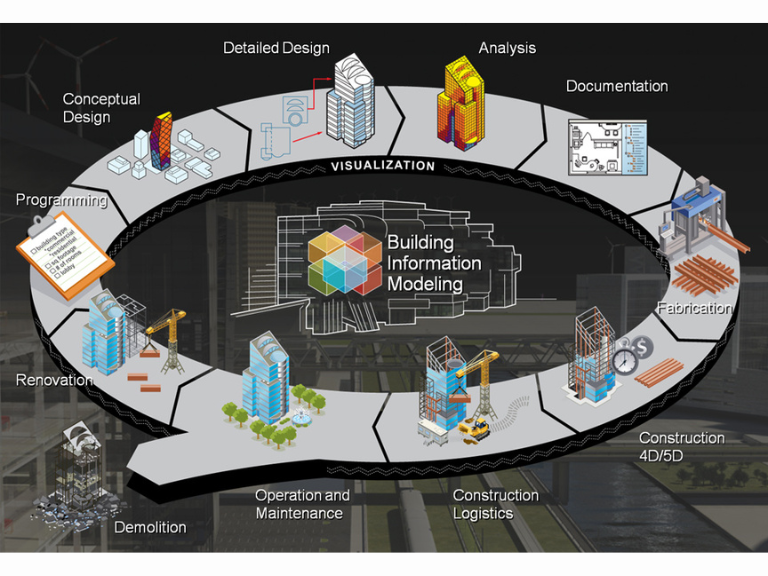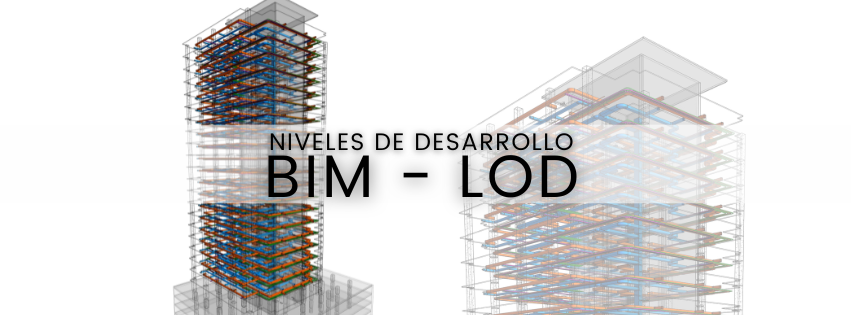The development of projects under the Methodology of Building Information Modeling (BIM) offers an efficient implementation using digital building models in a collaborative way, involving all specialties of the project.
The use of the Methodology BIM has expanded from the design and construction to the later phases of the project life cycle, such as the delivery, operations and maintenance, and even the dismantling and reuse.
Life cycle of the BIM project
Previous studies and Preliminary design
The life cycle of the project includes 7 stages, where the scope of the methodology BIM has different approaches:
-
Phase of feasibility studies / pre: this phase involves the recognition of the terrain where we will carry out the project, taking into account environmental factors, topographic, regulations.
The specialists involved are:
-
Architect
-
Surveyor
-
Geotechnical
-
Urban planner
Scope of BIM:
In this stage, the BIM model has as its scope the terrain modeling on the basis of information provided by the surveyor and the identification data of the project.
-
Phase design / Draft: in this phase, we develop the first design proposals, which are detailing with successive meetings.
The specialists involved are:
-
Architect
-
Designer
-
Client
-
Scope of BIM:Develop multiple options of design in parallel with the basic information of the elements and capturing technical information and costs.
Initial development and Project executive
-
Initial development stage: in this phase develops the solution for the chosen design of the alternatives presented, it is crucial to properly define the elements of a reference model (Coordinates, levels, etc), so that all the disciplines working in the same virtual space. In any case, the figure of the BIM Manager will guide the construction of the model.
The specialists involved are:
-
Modelers BIM architectural
-
Modelers BIM Engineering MEP,
-
Modelers BIM structure
Scope of BIM:
The architecture model will be preliminary with load-bearing structure, walls classified depending on the function, windows and doors, without information.
The model facilities will reflect the paths and the location of the equipment being compatible with the design solutions.
The model structure will consist of dimensions, enabling their integration into the design.
-
Phase of project execution: in this phase requires the project information, set the level of detail of each specialty.
The specialists involved are:
Calculation and dimension of the facilities and structure, through the development of analytical models, developing simulations to detect interference or changes in the design.
The modeling of the engineering standard is developed in different files, BIM, corresponding to the three main facilities, mechanical, electrical and hydraulic, in this way each of the files can be referenced in the model an architectural or structural in order to check the compatibility with the general model, independently or in conjunction.
The structural model works the same way it develops in a different file, but with the same references to be able to export it to the general model.
Construction and Operation
-
Construction phase: In this phase, In this phase of planning time and costs, it uses all the information contained in the BIM model to avoid delays and have savings in the project.
The specialists involved are:
-
Computers BIM of all specialties
-
Teams involved in the construction
Scope of BIM: The use of BIM in this phase allows you a complete organization of the process of construction, bringing a schedule of times between the different teams generating the procurement process and the supply of material is optimized.
During this phase, the model is still available to perform the necessary changes that take place during the work, in order to get the model As Built.
6. Phase of operation and maintenance: In this phase the methodology BIM with the model, As Built from the building allows it to follow the maintenance and operation of the building because in this model displays the entire building and is given the information, such as, maintenance date, dates of change of equipment, cleaning services, waste management of the building, budgets, management, technical and you can even schedule in this models the next maintenance.
Demolition
-
Phase of demolition or renovation: the Whole building has a shelf life, it is proposed that the buildings have a life expectancy of approximately between 50 and 75 years, so that the methodology BIM also provides for this phase with the aim of reducing the amount of waste and/or reuse of materials for the new building.
The methodology of Building Information Modeling (BIM) goes hand in hand with sustainability, helping the developers to plan projects and able to carry them out under specifications sustainable.
Develop projects under the methodology of Building Information Modeling (BIM) throughout the life cycle of guarantee, the development of a building more efficient, streamlined, productive, lower cost, greater control and better monitoring, anticipating errors at an early stage of the project.









